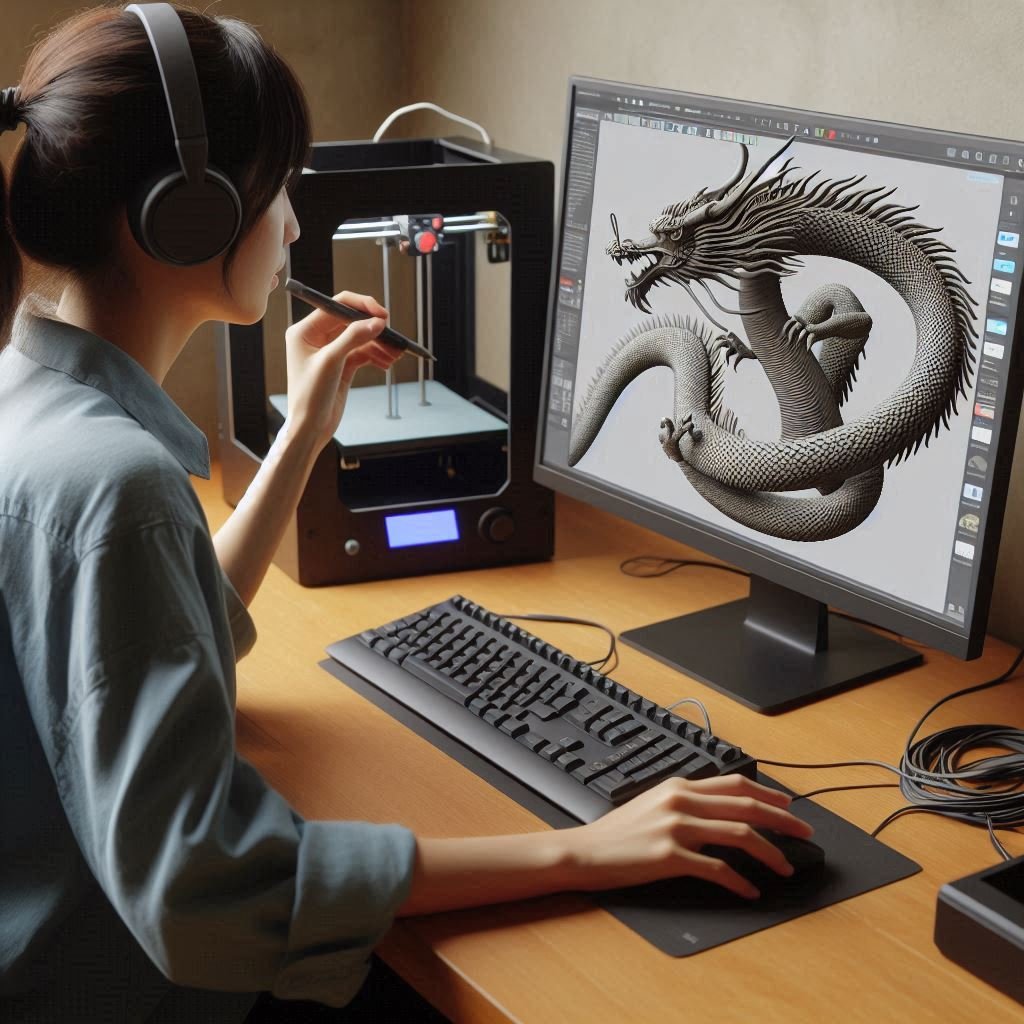Introduction
3D printing has revolutionized the way we create and manufacture objects, allowing individuals and businesses to bring their ideas to life with precision and ease. But before you can start printing, you need a 3D model. Creating 3D models for printing is a crucial skill that combines creativity with technical knowledge. Let’s dive into the process of creating 3D models that are ready for printing.
Understanding 3D Modeling Software
Popular 3D Modeling Software
To create a 3D model, you’ll need the right software. Some popular options include:
- Tinkercad: is user-friendly and great for beginners.
- Blender: Free and powerful, suitable for advanced modeling.
- Fusion 360: Offers professional-grade tools with a free version for personal use.
- SketchUp: Intuitive interface, ideal for architectural designs.
Choosing the Right Software for Your Needs
Selecting the right software depends on your skill level and the complexity of your project. Beginners might start with Tinkercad or SketchUp, while more experienced users may prefer Blender or Fusion 360 for their advanced features.
Getting Started with 3D Modeling
Basic Concepts and Terminology
Before jumping into modeling, familiarize yourself with some basic concepts:
- Vertices: Points in 3D space.
- Edges: Lines connecting vertices.
- Faces: Surfaces enclosed by edges.
- Meshes: are collections of vertices, edges, and faces that define the shape of your model.
Setting Up Your Workspace
Most 3D modeling software allows you to customize your workspace. Set up your grid, viewports, and toolbars to suit your workflow. This will make the modeling process more efficient and enjoyable.
Design Principles for 3D Printing
Understanding the Print Process
Knowing how 3D printing works will help you design better models. 3D printers build objects layer by layer, which means your model must be designed with this in mind to ensure successful printing.
Material Considerations
Different materials have different properties. Common 3D printing materials include PLA, ABS, and PETG. Consider the strength, flexibility, and finish of each material when designing your model.
Structural Integrity
Your model needs to be structurally sound to avoid print failures. Ensure that thin parts are reinforced and that the overall design can support its weight during printing.
Creating Your First 3D Model
Sketching and Planning
Start with a sketch or a plan. This can be a simple drawing or a detailed blueprint. Planning helps you visualize the final product and ensures you have a clear direction before you start modeling.
Basic Shapes and Forms
Begin with basic shapes like cubes, spheres, and cylinders. Most models can be built up from these simple forms. Combine and modify them to create more complex structures.
Extrusion and Boolean Operations
Extrusion is a fundamental tool that allows you to extend a shape along a path. Boolean operations (union, difference, and intersection) let you combine or subtract shapes to achieve the desired form.
Advanced Modeling Techniques
Working with Complex Shapes
As you gain confidence, experiment with more complex shapes. Use advanced tools like bezier curves, subdivision surfaces, and NURBS to create intricate models.
Sculpting and Organic Modeling
For organic shapes, such as characters or natural objects, sculpting tools are invaluable. Software like Blender offers powerful sculpting capabilities that let you manipulate the model as if you were working with clay.
Parametric and Generative Design
Parametric design involves creating models based on parameters that can be easily adjusted. Generative design uses algorithms to create optimized shapes. Both techniques are advanced but can lead to highly efficient and innovative designs.
Optimizing Models for 3D Printing
Ensuring Water tightness
Your model must be watertight, meaning there are no gaps or holes. Non-manifold edges and vertices can cause print failures, so use software tools to check and fix these issues.
Checking for Overhangs and Supports
Overhangs are parts of the model that extend outward and may require support during printing. Design your model with minimal overhangs or plan for support structures to ensure a successful print.
Reducing File Size and Complexity
High-resolution models can be very large and complex. Simplify your model by reducing polygon count where possible without compromising on detail. This makes the model easier to handle and print.
Exporting Models for 3D Printing
File Formats (STL, OBJ, etc.)
The most common file format for 3D printing is STL, but OBJ and 3MF are also popular. These formats preserve the necessary geometric data and can be easily imported into slicing software.
Preparing for Slicing
Ensure your model is correctly oriented and scaled. Double-check that all parts of the model are correctly aligned and that there are no hidden errors before exporting.
Using Slicing Software
What is Slicing?
Slicing is the process of converting your 3D model into instructions that the 3D printer can understand. Slicing software divides the model into thin layers and generates the G-code needed for printing.
Popular Slicing Software
Some widely used slicing software includes:
- Cura: is free and user-friendly.
- PrusaSlicer: Optimized for Prusa printers but versatile for others.
- Simplify3D: Paid software with advanced features.
Setting Up Your Print
Configure your slicing software with the correct printer settings, including layer height, print speed, and infill density. Preview the sliced model to ensure everything looks good before starting the print.
Printing Your Model
Preparing the 3D Printer
Ensure your 3D printer is clean and calibrated. Check the print bed alignment and apply any necessary adhesion aids, like glue sticks or tape.
Loading the Filament
Load the filament into the printer, following the manufacturer’s instructions. Make sure the filament feeds smoothly and without obstruction.
Starting the Print
Start the print and monitor the first few layers to ensure everything is working correctly. This is the most critical phase, as early issues can lead to print failures.
Post-Processing Your Print
Removing Supports
Carefully remove any support structures. Use tools like pliers and hobby knives to clean up the print without damaging it.
Sanding and Finishing
Smooth out the print with sandpaper or other finishing tools. This step improves the appearance and feel of the final product.
Painting and Decorating
For a personalized touch, paint and decorate your print. Use primers and paints suitable for the printing material to achieve the best results.
Common Issues and Troubleshooting
Warping and Layer Shifts
Warping occurs when the print cools unevenly. Ensure proper bed adhesion and maintain a stable temperature during printing to minimize this issue.
Print Failures
Print failures can result from various issues, such as clogged nozzles, incorrect settings, or mechanical problems. Regular maintenance and careful monitoring can prevent most failures.
Improving Print Quality
Experiment with different settings, materials, and techniques to continuously improve your print quality. Learn from each print and make adjustments as needed.
Tips and Best Practices
Regular Maintenance of Your 3D Printer
Keep your printer in good condition by performing regular maintenance. Clean the nozzle, check belts and screws, and calibrate the bed frequently.
Continuous Learning and Experimentation
3D printing is a constantly evolving field. Stay updated with new techniques, materials, and software by joining online forums, attending workshops, and reading industry publications.
Joining the 3D Printing Community
Engage with the 3D printing community. Share your work, seek advice, and collaborate on projects. Communities like Reddit, Thingiverse, and local maker spaces are great resources.
Future Trends in 3D Printing
Advances in 3D Printing Technology
Expect continuous advancements in printer technology, including faster print speeds, higher resolutions, and more reliable machines.
New Materials and Techniques
New materials, such as bio-inks and metal filaments, are expanding the possibilities of 3D printing. Stay informed about these developments to take advantage of new opportunities.
The Impact of 3D Printing on Various Industries
3D printing is transforming industries, from healthcare to aerospace. Its ability to produce custom, on-demand parts is revolutionizing manufacturing processes and product development.
Conclusion
Creating 3D models for printing is an exciting and rewarding endeavor that combines creativity with technical skill. With the right tools and knowledge, anyone can start designing and printing their own 3D objects. Remember to start simple, continuously learn, and engage with the community. The future of 3D printing is bright, and there’s no better time to dive in and start creating.
FAQs
What software is best for beginners in 3D modeling for printing?
Tinkercad and SketchUp are excellent choices for beginners due to their user-friendly interfaces and straightforward tools.
How do I ensure my model is printable?
Ensure your model is watertight, has no non-manifold edges, and is designed with appropriate supports for overhangs. Use software tools to check and repair any issues.
What are the common mistakes to avoid in 3D modeling for printing?
Avoid thin walls, complex geometries without supports, and not considering material properties. Also, ensure your model is properly scaled and oriented for printing.
Can I use free software to create professional-quality 3D prints?
Yes, many free software options, like Blender and Tinkercad, can produce professional-quality 3D models. The key is mastering the software and understanding the principles of good design.
How long does it take to learn 3D modeling?
The learning curve varies, but with consistent practice, you can grasp the basics in a few weeks. Advanced skills and techniques may take several months to a few years to master, depending on your dedication and the complexity of the models you wish to create.
Read More: How many smartphone manufacturers are there in the world?
Read more: How Long Do Digital Camera Batteries Last?
Read more: How Long Can Digital Cameras Record Video?

